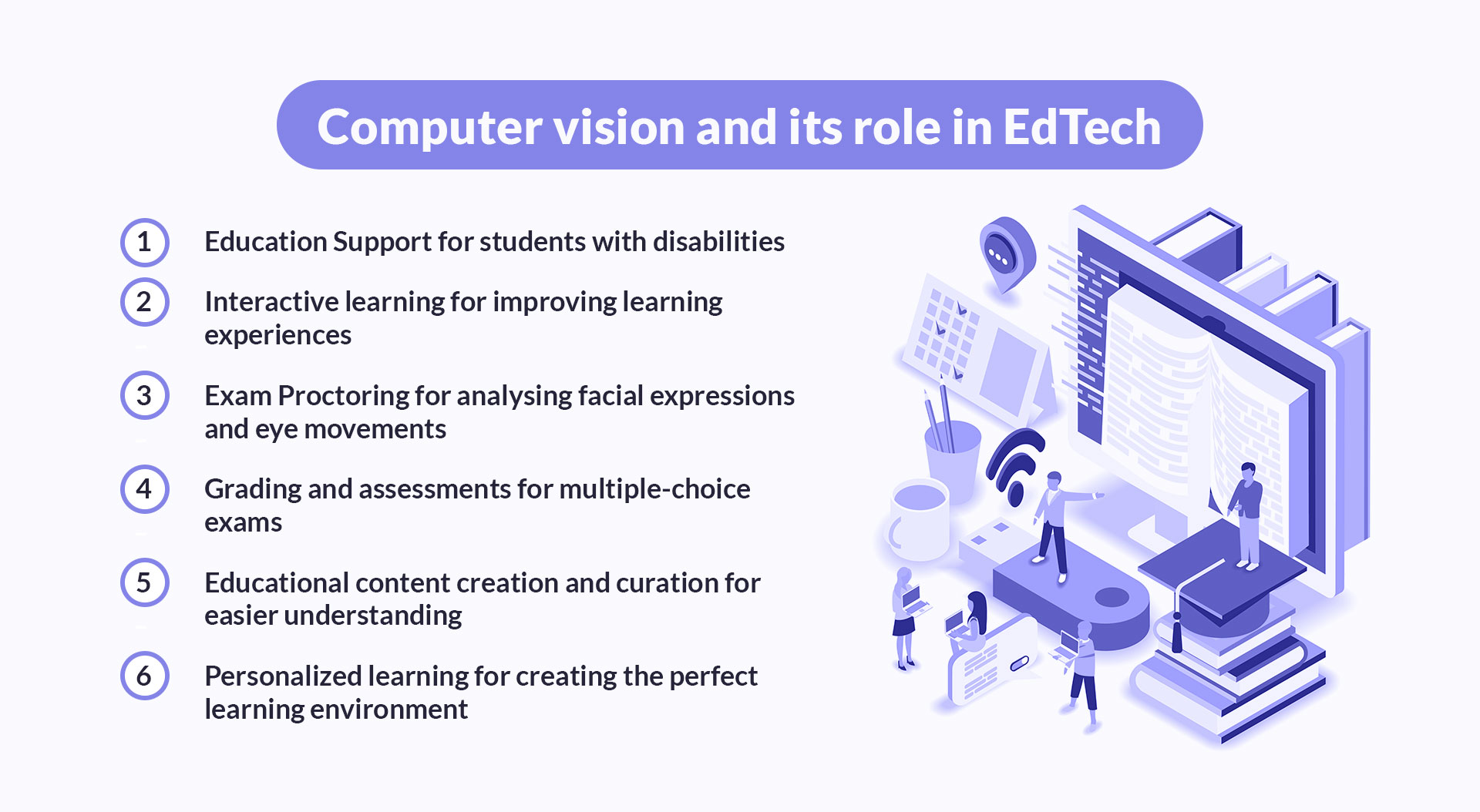The global e-learning market is taking the world by storm. Projections say it will reach $400 billion by 2026. As e-learning answers the demand for accessible, personalized learning, new tech applications have emerged. In fact, over 80% of college students say technology helps them study more efficiently and improve their academic performance. The use of new technologies such as the Internet of Things (IoT) and computer vision in education is taking EdTech a step further.
Through technology, we’re making learning personalized and multi-dimensional. Read on to learn how you can use computer vision and IoT to stay on top in the EdTech industry.
Computer vision and its role in EdTech

Simply put, computer vision is a section of artificial intelligence (AI). Its main goal is to enable machines to collect and interpret visual data like humans.
But how can computers do this? The answer is two-fold. First, you need hardware to capture the visual input. For example, these can be computer vision cameras, sensors, or imaging devices. Once data is collected, software solutions come into play. Programs can extract features, classify objects, and recognize patterns using machine learning algorithms and training data.
Depending on what computer vision algorithms you use and your intent, you can get different results. Here are the main capabilities of computer vision systems:
Object detection
Object recognition
Pattern recognition
Optical character recognition (OCR)
Facial recognition
Expression analysis
Pose estimation
Action recognition
Image classification and segmentation
3D reconstruction
Augmented/virtual reality.
So, let’s see how these capabilities can revolutionize education. The applications of computer vision in education can range from special education support to interactive learning.
Education support. Computer vision technology can help school students with disabilities master the learning content. Thanks to deep learning, it can tag digital images based on the objects that appear in them. Then, it can translate images into speech by describing them in natural language.
Interactive learning. The use of computer vision can improve learning experiences by making them more interactive. For example, it can create 3D models of objects and encourage students to interact with learning materials in new ways. Student responses would then direct future interactions.
Exam proctoring. Computer vision systems can analyze facial expressions and eye movements. This can help detect any issues either during class or in proctored exams. In essence, this allows for attention tracking to ensure each student is focused on the materials in front of them.
Grading and assessments. Schools have been using automated grading systems for multiple-choice exams for a while. But the exciting news is that thanks to computer vision technology, they can now also use them for other types of assessments. With a little help from OCR, instructors can easily grade even traditional pen-and-paper exams and essay questions for insights into students’ understanding.
Educational content creation and curation. Computer vision algorithms can help with teaching and learning through video captions and summaries. By analyzing and tagging visual content using deep learning models, they help with video processing. But there’s more. It can also organize and group topics and concepts for easier understanding.
Personalized learning. It’s not easy for teachers to create the perfect learning environment for each student. However, implementing computer vision in educational settings can help. Imagine having a constant measure of student engagement and understanding at your fingertips. That’s exactly what this technology can provide. But it gets even better. By combining computer vision with deep learning and other forms of artificial intelligence, the algorithm will create a personalized learning path for individual students.
IoT in educational technology
The Internet of Things (IoT) is a network of interconnected devices that exchange data with each other over the internet. These devices can range from household items to classroom boards to industrial equipment. Most importantly, they have sensors, software, and other technologies that allow them to perform tasks without human intervention.
The confluence of computer science and artificial intelligence has immense transformative potential in education, as well as many other industries. Educational institutions can now provide students with a range of IoT devices to modernize their education. These include:
Smart boards
Screen readers
Tablets
Gadgets and wearables.
These tools have opened the door to smart classrooms and automated attendance tracking. But they also improved personalization, accessibility, and collaboration. Let’s review what benefits IoT devices bring to the learning process.
Increased interactions and engagement. IoT-enabled devices can do wonders for student engagement. Smart boards, tablets, gadgets, and wearables are more engaging than traditional learning materials. Learners can use the materials in different ways, alter them, run scenarios, and collaborate with others. Other than being more effective, students also find active learning methodology and teaching methods more fun.
Personalization and accessibility. With the help of IoT devices, learning can be available to anyone, anytime, anywhere. It will cater to the student’s experience, abilities, learning style, and preferences. Plus, it will provide instant feedback on a student’s progress. Analytics can provide insight for students and teachers as they progress through programs.
Experiential learning. When paired with computer vision applications and deep learning models, IoT devices can create immersive experiences that will transform education. Imagine putting on a pair of virtual reality glasses to enter a 19th-century battlefield in full gear and experience what happened first-hand. It sure beats reading a textbook with names and numbers that don’t mean anything to you.

More from our blog
Personalized learning in education: AI tools for edtech
Personalized learning in education is on the rise. Professionals are looking for AI tools to boost engagement, and now you can, too.
Read moreIoT and computer vision use cases in the education sector
The intersection of computer vision systems and IoT in education creates many possibilities. Think of computer vision as the software that allows machines to see like humans, and IoT is the catalyst to act on that information.
Computer vision, just like any other technology, is a tool. And as we integrate it with education, we are setting the path for many future generations, possibly even society as a whole.
So, let’s explore how the education sector could benefit from pairing a computer vision system with IoT.
Computer vision | IoT follow-up | Benefit |
Attendance tracking (face recognition) | If a student is not present, send an alert to the teacher/admin/parent | Improved attendance rates, security, learning |
Emotion detection | Increase/decrease content complexity, alert staff | Improved learning, motivation, personalization, security |
VR/AR experiences for active engagement | Adapt scenarios based on prior interactions | Immersive, gamified learning, motivation |
3D modeling | Manipulate models based on new information | Improved experience and confidence in design |
Assessment and progress reports | Provide additional instruction/explanation based on academic performance | Instant, actionable feedback and insights into students’ capabilities for personalization/improvement |
But enough with the theory. Let’s see some real-world computer vision applications in education.
Indian Institute of Technology (IIT) Bombay is working on smart classrooms. They have connected computer vision technology with smart devices through an app. The goal was to set up objective, proctored exams and provide an instant measure of student performance. Their initiative resulted in the deployment of SAFE (Smart Authenticated Fast Exams). By using the students’ devices, the educational experience improved without compromising privacy.
Southern New Hampshire University is spearheading the computer vision revolution. What initially got them the attention was their use of 3D holographic models to teach architecture. But that was just the beginning. Other than implementing active learning principles, their Sandbox ColLABorative initiative is making education what it should be: engaging, collaborative, and visionary. This computer vision system is connected with IoT to create the next-generation incubator.
Rensselaer Polytechnic Institute has a unique way of teaching their students Mandarin. They took advantage of artificial intelligence and neural networks to create an immersive learning experience. By connecting a computer vision system with AI educational apps, researchers created a virtual classroom for language learning. Students would enter this cognitive immersion room and interact with an AI chatbot. From the student’s perspective, they would find themselves in a simulated restaurant in China, making small talk with the waiter. What’s best about this is personalized learning experiences where student behavior would steer each interaction.
These are just a few potential computer vision applications in EdTech. If you have your own ideas, we can help you bring them to life. Here at Geniusee, we have diverse teams that can develop customized education software solutions to help you bring innovation and outshine the competition.


Thank you for Subscription!
The future of emerging technologies in EdTech
Computer vision, deep learning, and IoT have made great strides in recent years. With those advancements also came new educational apps that are transforming education. Object detection in computer vision technology has brought many new possibilities. It also opened the door to detecting facial features to identify students. And as much as these advancements are beneficial, they also bring new privacy risks.
So, let’s see what the future holds for computer vision and IoT in education:
Wider access to alternate reality and virtual reality courses
Real-time collaboration opportunities on-site and virtually with anyone in the world
Improved personalization and engagement levels through advancements in emotion detection and based on individual learning styles and pace
Increased scalability with faster internet, improved sensors, and algorithms
Balancing security and privacy to ensure sensitive data is protected without compromising system integrity.
Note that this is still a developing field, and these are just some of the potential future computer vision examples for education. EdTech companies that want to implement computer vision should start by understanding its potential and current limitations. With a thorough understanding of computer vision technology and modern educational challenges, forward-thinkers will invent new applications.
Conclusion
Computer vision systems have transformative potential for traditional education and online learning. Brick-and-mortar facilities can greatly benefit from its security features, as well as educational implications. Pairing computer vision with IoT can prevent security incidents and put protections in place. But that’s just one aspect of it.
A comprehensive computer vision system can also answer the demand for personalized, engaging, and effective learning. Integrating IoT devices with other AI-based technologies has set the stage for powerful uses of computer vision in education. But, we must use technology responsibly to maximize its long-term impact on society.





















